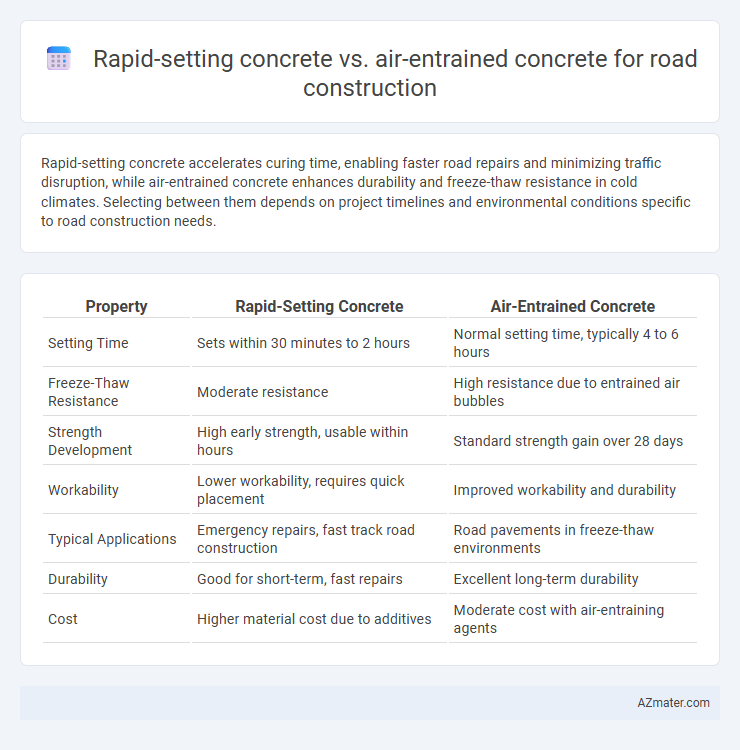Rapid-setting concrete accelerates curing time, enabling faster road repairs and minimizing traffic disruption, while air-entrained concrete enhances durability and freeze-thaw resistance in cold climates. Selecting between them depends on project timelines and environmental conditions specific to road construction needs.
Table of Comparison
| Property | Rapid-Setting Concrete | Air-Entrained Concrete |
|---|---|---|
| Setting Time | Sets within 30 minutes to 2 hours | Normal setting time, typically 4 to 6 hours |
| Freeze-Thaw Resistance | Moderate resistance | High resistance due to entrained air bubbles |
| Strength Development | High early strength, usable within hours | Standard strength gain over 28 days |
| Workability | Lower workability, requires quick placement | Improved workability and durability |
| Typical Applications | Emergency repairs, fast track road construction | Road pavements in freeze-thaw environments |
| Durability | Good for short-term, fast repairs | Excellent long-term durability |
| Cost | Higher material cost due to additives | Moderate cost with air-entraining agents |
Introduction to Rapid-Setting and Air-Entrained Concrete
Rapid-setting concrete accelerates curing time, enabling quicker road construction and reopening by achieving early strength within hours, ideal for urgent repairs and high-traffic areas. Air-entrained concrete incorporates microscopic air bubbles that enhance freeze-thaw durability, reduce scaling, and improve resistance to deicing chemicals, ensuring long-term performance in climates with temperature fluctuations. Both types are critical in modern road construction, where rapid deployment and durability against environmental stressors determine infrastructure longevity and safety.
Key Properties of Rapid-Setting Concrete
Rapid-setting concrete in road construction exhibits accelerated strength gain within hours, enabling faster project completion and reduced downtime. It features low water-cement ratio and high early compressive strength, often exceeding 4,000 psi within 24 hours, making it ideal for emergency repairs. This concrete type also offers superior resistance to freeze-thaw cycles and chemical erosion, enhancing durability on heavily trafficked roadways compared to conventional air-entrained concrete.
Key Properties of Air-Entrained Concrete
Air-entrained concrete contains microscopic air bubbles that enhance freeze-thaw durability and improve resistance to scaling caused by deicing chemicals, making it ideal for road construction in cold climates. Its key properties include increased workability, reduced permeability, and enhanced resistance to thermal cracking, which contribute to longer pavement life. Compared to rapid-setting concrete, air-entrained concrete offers superior resistance to environmental stresses, although it sets more slowly and is less suitable where fast curing is required.
Application Suitability in Road Construction
Rapid-setting concrete is ideal for emergency repairs and projects requiring minimal downtime due to its fast strength gain, making it suitable for patching potholes and reopening roads quickly. Air-entrained concrete offers superior freeze-thaw durability by incorporating microscopic air bubbles, which prevent cracking and scaling in climates with frequent temperature fluctuations. Choosing between the two depends on project urgency and environmental conditions, with rapid-setting prioritized for quick usability and air-entrained for long-term resilience in cold regions.
Durability and Weather Resistance Comparison
Rapid-setting concrete offers superior early strength development, making it ideal for quick repairs and minimizing road closure times, but it often has lower long-term durability compared to air-entrained concrete. Air-entrained concrete enhances durability in freeze-thaw cycles by incorporating microscopic air bubbles that prevent internal pressure buildup, significantly improving weather resistance in cold climates. For road construction in regions prone to freeze-thaw damage and severe weather, air-entrained concrete provides better long-term performance and resilience against cracking and scaling.
Setting Time and Construction Speed
Rapid-setting concrete achieves initial set within 30 minutes to 2 hours, significantly accelerating construction speed for road projects requiring quick reopening. Air-entrained concrete, known for enhanced durability against freeze-thaw cycles, typically sets within 4 to 6 hours, which slows down the overall construction timeline. Selecting rapid-setting concrete benefits time-sensitive road repairs, while air-entrained concrete is preferred for long-term durability in harsh climates.
Cost Considerations and Budget Impacts
Rapid-setting concrete often incurs higher upfront costs due to specialized admixtures and expedited curing processes, impacting initial budget allocations in road construction projects. Air-entrained concrete typically offers cost savings by reducing potential freeze-thaw damage and extending pavement lifespan, minimizing long-term maintenance expenses. Budget planning must weigh rapid-setting concrete's faster project turnaround against air-entrained concrete's enhanced durability and life-cycle cost benefits.
Performance Under Traffic Loads
Rapid-setting concrete provides faster strength gain, enabling quicker reopening of roads to traffic and reducing downtime in road construction projects. Air-entrained concrete enhances resistance to freeze-thaw cycles and deicing chemicals, improving durability under harsh weather conditions and heavy traffic loads. Both materials offer distinct advantages: rapid-setting concrete excels in accelerated load-bearing capacity, while air-entrained concrete ensures long-term pavement resilience and reduced surface cracking.
Maintenance Requirements and Lifespan
Rapid-setting concrete offers shorter curing times, enabling quicker restoration of roadways with reduced maintenance intervals due to its early strength development. Air-entrained concrete enhances durability by incorporating microscopic air bubbles that improve freeze-thaw resistance, significantly extending the pavement's lifespan and minimizing surface scaling and cracking. Roads constructed with air-entrained concrete typically require less frequent repairs over time compared to rapid-setting concrete, which may be more susceptible to long-term wear under harsh environmental conditions.
Choosing the Right Concrete for Road Projects
Rapid-setting concrete accelerates curing time, allowing roads to reopen quicker, which is crucial for minimizing traffic disruption in urban areas. Air-entrained concrete enhances durability by improving freeze-thaw resistance and reducing surface scaling, making it ideal for regions with harsh winter conditions. Selecting the right concrete depends on project timelines and environmental factors, ensuring longevity and cost-effectiveness in road construction.

Infographic: Rapid-setting concrete vs Air-entrained concrete for Road construction
 azmater.com
azmater.com